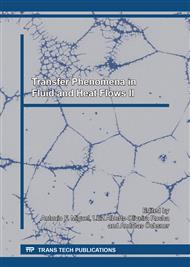[1]
D. Jua, Y. Man-Ni, Y. Shi-Fang, Correlations and optimization of a heat exchanger with offset fins by genetic algorithm combining orthogonal design, Appl. Therm. Eng. 107 (2016) 1091-1103.
DOI: 10.1016/j.applthermaleng.2016.04.074
Google Scholar
[2]
A. A. Bhuiyan, A. K. M. Sadrul Islam, Thermal and hydraulic performance of finned-tube heat exchangers under different flow ranges: a review on modeling and experiment, Int. J. Heat Mass Transfer 101 (2016) 38-59.
DOI: 10.1016/j.ijheatmasstransfer.2016.05.022
Google Scholar
[3]
H. Peng, X. Ling, J. Li, Performance investigation of an innovative offset strip fin arrays in compact heat exchangers, Energy Convers. Manage. 80 (2014) 287-297.
DOI: 10.1016/j.enconman.2014.01.050
Google Scholar
[4]
N. Zhao, J. Yang, S. Li, Q. Wang, Numerical investigation of laminar thermal-hydraulic performance of Al2O3–water nanofluids in offset strip fins channel, Int. Commun. Heat Mass Transfer 75 (2016) 42-51.
DOI: 10.1016/j.icheatmasstransfer.2016.03.024
Google Scholar
[5]
J. Fernández-Seara, R. Diz, F. J. Uhía, Pressure drop and heat transfer characteristics of a titanium brazed plate-fin heat exchanger with offset strip fins, Appl. Therm. Eng. 51 (2013) 502-511.
DOI: 10.1016/j.applthermaleng.2012.08.066
Google Scholar
[6]
A. Bejan, Shape and Structure, from Engineering to Nature, Cambridge University Press, Cambridge, UK, (2000).
Google Scholar
[7]
A. Bejan, S. Lorente, Design with Constructal Theory, Wiley, Hoboken, (2008).
Google Scholar
[8]
A. Bejan, J. P. Zane, Design in Nature, Doubleday, New York, (2012).
Google Scholar
[9]
L. A. O. Rocha, S. Lorente, A. Bejan, Constructal Law and the unifying principle of design, Springer-Verlag, (2013).
Google Scholar
[10]
A. Bejan, G. W. Merkx, Constructal theory of social dynamics, Springer, New York, (2007).
Google Scholar
[11]
A. F. Miguel, The emergence of design in pedestrian dynamics: Locomotion, self-organization, walking paths and constructal law, Phys. Life Rev. 10 (2013) 168-190.
DOI: 10.1016/j.plrev.2013.03.007
Google Scholar
[12]
A. Bejan, S. Lorente, The constructal law and the evolution of design in nature, Phys. Life Rev. 8 (2011) 209–240.
Google Scholar
[13]
A. Bejan, S. Lorente, The constructal law makes biology and economics be like physics Reply to comments on The constructal law and the evolution of design in nature, Phys. Life Rev. 8 (2011) 261-263.
DOI: 10.1016/j.plrev.2011.08.001
Google Scholar
[14]
A. Bejan, J. H. Marden, The constructal unification of biological and geophysical design, Phys. Life Rev. 6 (2009) 85-102.
DOI: 10.1016/j.plrev.2008.12.002
Google Scholar
[15]
C. Biserni, L. A. O. Rocha, A. Bejan, Inverted fins: geometric optimization of the intrusion into a conducting wall, Int. J. Heat Mass Transfer 47 (2004) 2577-2586.
DOI: 10.1016/j.ijheatmasstransfer.2003.12.018
Google Scholar
[16]
G. Lorenzini, L. A. O. Rocha, Constructal design of Y-shaped assembly of fins, Int. J. Heat Mass Transfer 49 (2006) 4552-4557.
DOI: 10.1016/j.ijheatmasstransfer.2006.05.019
Google Scholar
[17]
A. K. Prasad, J. R. Koseff, Reynolds Number and End-wall Effects on a Lid-driven Cavity Flow, Phys. Fluids A 1 (1989) 208-218.
DOI: 10.1063/1.857491
Google Scholar
[18]
L. -S. Lin, Y. -C. Chen, C. -A. Lin, Multi relaxation time lattice Boltzmann simulations of deep lid driven cavity flows at different aspect ratios, Comput. Fluids 45 (2011) 233–240.
DOI: 10.1016/j.compfluid.2010.12.012
Google Scholar
[19]
R. Iwatsu, J. M. Hyun, Threedimensional driven-cavity flows with a vertical temperature gradient. Int. J. Heat Mass Transfer 38 (1995) 3319 – 3328.
DOI: 10.1016/0017-9310(95)00080-s
Google Scholar
[20]
Y. Song, M. Asadi, G. Xie, L. A. O. Rocha, Constructal wavy-fin channels of a compact heat exchanger with heat transfer rate maximization and pressure losses minimization, Appl. Therm. Eng. 75 (2015) 24-32.
DOI: 10.1016/j.applthermaleng.2014.05.027
Google Scholar
[21]
S. V. Patankar, Numerical heat transfer and fluid flow, McGraw Hill, New York, (1980).
Google Scholar
[22]
H. K. Versteeg, W. Malalasekera, An introduction to computational fluid dynamics – the finite volume method, Pearson, England, (2007).
Google Scholar
[23]
Fluent (version 6. 3. 16), ANSYS, Inc., (2007).
Google Scholar
[24]
A. Bejan, Convection Heat Transfer, John Wiley, Durham, USA, (2014).
Google Scholar


